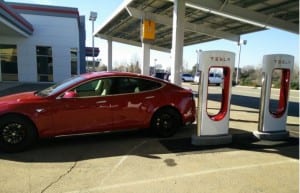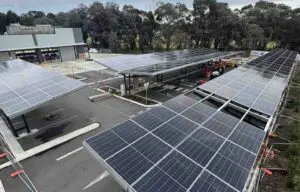Leading economist Professor Ross Garnaut and two government renewable energy agencies are championing the use of hydrogen to exploit Australia’s massive solar and wind resources.
They say it would make Australia a renewable energy powerhouse, allowing to build huge arrays of solar fields, and creating an export industry of “solar fuels” to northern Asia that would rival the coal and gas export industries.
At a conference in Sydney this week, Professor Garnaut – who was the Labor government advisor on climate change – also said the use of zero emissions hydrogen could also attract energy intensive industries to Australia using cheap renewable energy, making Australia a super-power” of the global low-carbon economy.
“Australia has more opportunities in the low-carbon future than in the fossil fuels of the past,” he told the 6th World Hydrogen Technologies Convention.
“Australia will be the world’s lowest cost source of renewable energy …. and Australia will become the logical location for energy intensive industries.”
Oliver Yates, the CEO of the Clean Energy Finance Corporation, agreed, saying that hydrogen was the next big step to make renewable energy rival and overtake fossil fuels. “Australia is blessed with unlimited renewable energy resources. It has unlimited amounts of sun, and wind and wave,” Yates told the conference in a keynote address.
 “Creating an export market for those resources is a natural step for our economy.” He noted that Australia has “hundreds and hundreds” of gigawatts of stranded (meaning undeveloped) renewable energy around Australia. “It is perfect for hydrogen. It is stranded, it’s cheap and it’s available.”
“Creating an export market for those resources is a natural step for our economy.” He noted that Australia has “hundreds and hundreds” of gigawatts of stranded (meaning undeveloped) renewable energy around Australia. “It is perfect for hydrogen. It is stranded, it’s cheap and it’s available.”
Yates is also excited about the possibilities of creating a network of hydrogen refueling stations across Australia, particularly following the National Broadband Network in regional areas, where the cost of transport fuels is prohibitive.
“We like the hydrogen space, it is versatile, transportable and flexible … and it is economic in regional Australia right now.
The idea of renewable hydrogen is not limited to solar. It could take advantage of excess power from wind and hydro – indeed one of the early hydrogen export projects could take place in Tasmania.
But the vision doesn’t stop there. Some advocates are talking of vast solar arrays – of the scale of tens of gigawatts (yes, gigawatts) – that would use electrolysis to convert solar power into hydrogen, and have this shipped to Japan in the form of ammonia. This would rival the scale of the coal and LNG export industries.
Others talk of individual systems that would allow households to convert the excess power from their rooftop solar PV arrays into hydrogen, for use in their hydrogen fuel cell vehicle.
Others, including Yates, talk of hydrogen fuel cells to be used in buses, trucks and other heavy vehicles, even tractors, and of fleets of FCVs (fuel cell vehicles) to be used for rentals or government or business groups.
The hydrogen economy has been talked about for years, and it’s true to say that many have been, and still are, skeptical. They say that the distribution networks for hydrogen are expensive. They are. But their defenders say it is simply a matter of scale, and liken it to solar in the late 1990s or early 2000s.
But there are now a couple of powerful reasons why the hydrogen economy may rapidly emerge, and achieve those economies of scale. Two of those reasons are Germany and Japan, and the third is the Paris climate change conference.
Germany is phasing out nuclear and plans a high penetration renewable energy grid – 80 per cent by 2050. It is now looking at hydrogen to provide large-scale storage, both for generation and industrial processes.
Germany is rapidly scaling up R&D in technologies such as electrolysis, which uses electricity from solar or wind power, and then adds water to produce hydrogen (and oxygen). Its efforts are being compared to its big push for renewables, that led to the big falls in solar costs over the past decade.
Japan is also thinking of alternatives to nuclear, following the Fukushima disaster, and alternatives to oil and gas imports, and the emissions that come with it. It is also looking to hydrogen for the same purposes – as a transport fuel, for distributed and large scale power generation, and for industrial uses.
The Sydney hydrogen technologies conference has attracted 350 delegates from Australia and around the world, including a big contingent from Japan, including Toyota is pushing hydrogen cars, and unveiled its Mirai car at the conference.
Heavy industry is also present, including Toyota, Sumitomo, Kawasaki, Chiyoda, Iwatani, and others, along with government representatives and universities.
Japan is looking to hydrogen because it needs zero emissions fuel, and diversify away from fossil fuel imports, which account for 80 per cent of its total energy needs.
It has announced an energy plan that includes support for hydrogen fuel cells in homes, hydrogen fuel cell cars, and a refueling network, and then for hydrogen to be used in power plant generation and industrial processes.

Toyoto is producing 700 Mirai FCVs this year and 3,000 by 2017, and Honda and Nissan will follow in coming years. So far, 27 refuelling stations have been built and some 130,000 homes have the Ene-farm fuel cell in their homes.
“We are in the first year of a hydrogen society in Japan,” said Shintaro Matsumuto, from the government agency NEDO.
Japan intends to start importing hydrogen from around 2030, but while Australian hydrogen advocates talk of using solar and other renewables, and acknowledge use of some fossil fuels in the initial period, they are surprised by the Japanese focus on cheap brown coal deposits in Victoria.
Matsumuto said initial projects would be based around fossil fuels for feed stock, particularly brown coal, although he insisted that Japan was looking to renewable energy – and for the hydrogen to be Co2 free – by 2040.
Toshimi Okada, from Chiyoda Corp, agreed the first step would be in fossil fuel hydrogen, before a gradual move to renewale energy. “Solar … with electrolysis …. has much potential in Australia,” he said.
However, Kawasaki Heavy Industries outlined a plan to build a pilot plant for brown coal gasification in the Latrobe Valley, with a full scale commercial plant by 2030, using offshore oil and gas fields for carbon capture and storage.
“Australia has enough brown coal to power Japan for 200 years,” Kawasaki’s Yasushi Yoshino told the conference. His company is counting on the success of the Carbon-Net CCS scheme, which is still just at the early feasibility stage, and there still being an appetite from brown coal mining in a decade’s time.
The commitment by Japan’s industrial heavyeights to put so much emphasis on fossil fuels prompted some dismay from the Australian audience. Attilio Pigneri, the chairman of the Congress, wondered if there was a “disconnect” between Japanese and Australian intentions.
Raoul Abrutat, a hydrogen enthusiast from Perth-based commercial solar firm Solarmatrix, said he was “shocked” that the Japanese hydrogen road map was based on fossil fuels.
“You are looking at the wrong state,” he said. “You should come to Western Australia and our solar resources,” he said. Andrew Want, from Renewable Hydrogen, who is planning a solar-to-hydrogen pilot plant in the Pilbara, echoed his comments. (We will have more on his plans on Thursday).
Others said the focus on brown coal highlighted how desperate the Japanese were for hydrogen fuels. Given the likely outcome of the Paris talks, the potential costs of CCS (if it works), then they would likely to turn quickly to renewable energy alternatives.
Meanwhile, Yates said the CEFC was interested in financing early developments in hydrogen fuel networks, and the Australian Renewable Energy Agency said it is also interested.
ARENA’s Danny De Schutter said hydrogen offered flexibility to balance out the output from rooftop solar and wind plants, allowing increased renewable generation, and offered new uses for renewable energy, such as a clean – and potentially cheaper – alternative to natural gas. And it could be used in off-grid situations, offering an alternative to solar and battery storage.
He said ARENA was looking to support some hydrogen projects, but the ones submitted to date had not been compelling.
“We have been looking at battery storage, but we are now turning our attention to hydrogen,” he said. “We will support feasibility studi”es and policy development and help get projects off the ground. We have received some proposals, but they are not yet of the quality for investment.”
“Hydrogen is the holy grail to unlock Australia’s renewable energy potential. If we can facilitate that – it will be a key to a clean energy future,” said Amy Kean, the NSW government’s renewable energy advocate.










